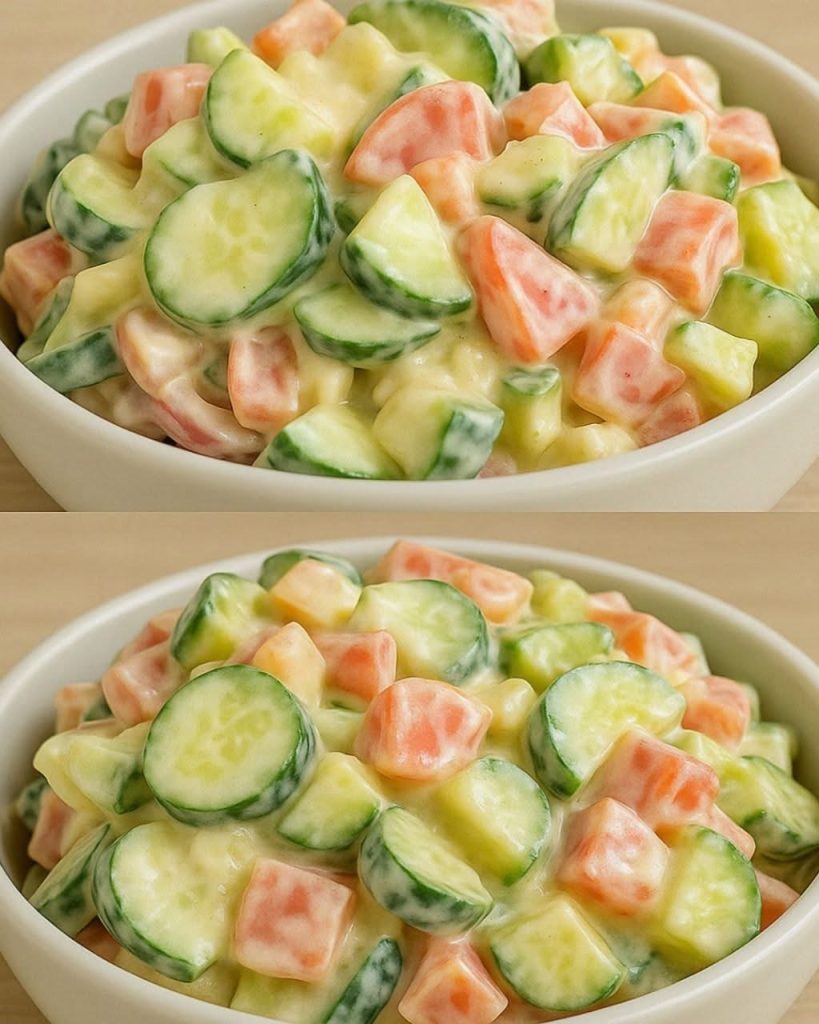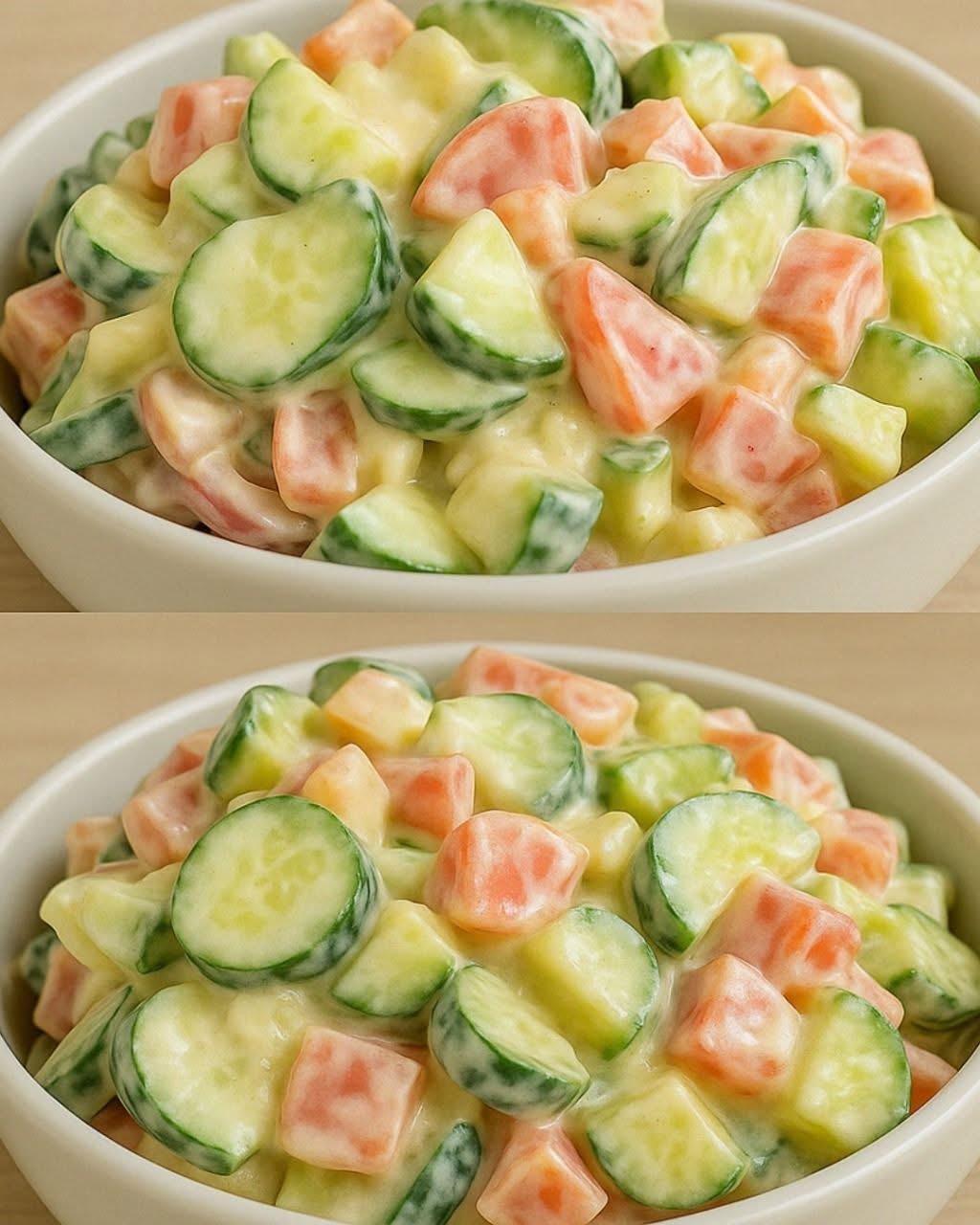Creamy Vegetable Salad: A Colorful, Crunchy Classic

Overview
Creamy vegetable salad is a beloved side dish known for its cool, crisp texture and rich, tangy dressing. It’s a popular choice across many cultures, often served at potlucks, picnics, or as a refreshing accompaniment to hearty mains. The beauty of this salad lies in its simplicity: raw or lightly blanched vegetables are diced and tossed with a creamy, often mayonnaise-based dressing.
Ingredients
While variations abound, the salad in the photo appears to include:
Cucumbers – Sliced into half-moons for a crisp bite.
Carrots – Diced for a sweet crunch and vibrant color.
Potatoes or Apples – These light-yellow cubes may be boiled potatoes or tart apples like Granny Smith, adding a starchy or sweet contrast.
For the dressing, common ingredients include:
Mayonnaise or yogurt (or a mix of both)
Lemon juice or vinegar
Sugar or honey (for a touch of sweetness)
Salt and pepper
Optional: mustard, garlic powder, or onion powder
Preparation Method
- Prep the vegetables: Wash and peel as needed. Dice uniformly for even texture.
- Optional blanching: Carrots or potatoes can be lightly boiled for a tender-crisp texture.
- Mix the dressing: Combine mayonnaise/yogurt with seasoning, adjusting to taste.
- Combine: Toss the chopped vegetables with the dressing until evenly coated.
- Chill: Refrigerate for at least 30 minutes before serving for the best flavor and texture.
Variations
Protein boost: Add diced boiled eggs, shredded chicken, or chickpeas.
Fruits: Add apples, pineapple chunks, or raisins for a sweet-savory twist.
Herbs: Fresh dill, parsley, or chives enhance the flavor profile.
Spice it up: A pinch of cayenne, paprika, or crushed red pepper can add heat.
Nutrition Profile
This salad is:
Rich in fiber from raw vegetables
A source of vitamins A and C
Customizable to be lower-fat (using yogurt or low-fat mayo)
However, watch portion size if using full-fat mayonnaise, which adds calories and fat.
Serving Ideas
As a side dish to grilled meats, sandwiches, or rice dishes.
As part of a buffet spread or picnic.
In a wrap or pita pocket for a quick vegetarian lunch.
Storage
Store in an airtight container in the refrigerator for up to 2 days. Note: some vegetables may release water over time, slightly thinning the dressing.
Global Twists
Different cultures have similar salads with regional flavors:
Russian Olivier Salad: Adds peas, ham, pickles, and boiled eggs.
Japanese Potato Salad: Creamy with mashed potatoes, cucumbers, carrots, and a hint of rice vinegar.
Filipino Macaroni Salad: Includes pasta, mayo, chicken, raisins, and pineapple chunks.
You could adapt the base salad in the image with any of these influences to create fusion dishes.
- Presentation Styles
Elevate your salad with these plating ideas:
Serve in lettuce cups or small bowls for individual portions.
Use cookie cutters to shape vegetables into stars or hearts for a kid-friendly version.
Garnish with fresh herbs, a drizzle of olive oil, or a dusting of paprika or sumac for color.
- Texture & Flavor Enhancers
Add-ins to improve complexity:
Crunchy: Toasted nuts (like walnuts or almonds), croutons, or crispy fried onions.
Tangy: Pickles, olives, or a splash of apple cider vinegar.
Sweet: Diced apples, grapes, or dried cranberries.
- Make It a Meal
Turn the side salad into a complete dish:
Mix in quinoa, pasta, or couscous for carbs.
Top with grilled chicken, tofu, or tuna for protein.
Wrap in a tortilla or pita for a quick and satisfying lunch.
- Dietary Adaptations
Low-fat version: Use Greek yogurt, light mayo, or mashed avocado as the base.
Keto-friendly: Omit carrots and apples; use zucchini, celery, and cheese.
Vegan: Use plant-based mayo or cashew cream.
- Entertaining Tip
Make a DIY salad bar: Offer chopped veggies, multiple dressings, and mix-ins so guests can customize their own creamy salad bowl
